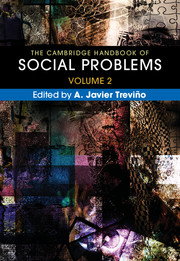Book contents
Part II - Problems Related to Crime and Violence
Published online by Cambridge University Press: 16 March 2018
Summary
Crime is deemed by many, if not most, people to be one of the most disquieting social problems. However, most people are more familiar with myths about crime rather than about its realities. Furthermore, the general public tends to have a narrow conception of crime, one that is limited to acts of predatory “street crimes,” such as physical assaults and robberies that occur in public places. As well, there is widespread belief that “criminals” are fundamentally different from “noncriminals.” A key objective of this chapter is to challenge such conventional wisdom about crime. Special attention is also devoted to explicating the disagreement within the academic community over what behaviors, conditions (e.g., physical appearance), and people should and should not be labeled criminal.
Information
- Type
- Chapter
- Information
- The Cambridge Handbook of Social Problems , pp. 197 - 472Publisher: Cambridge University PressPrint publication year: 2018
